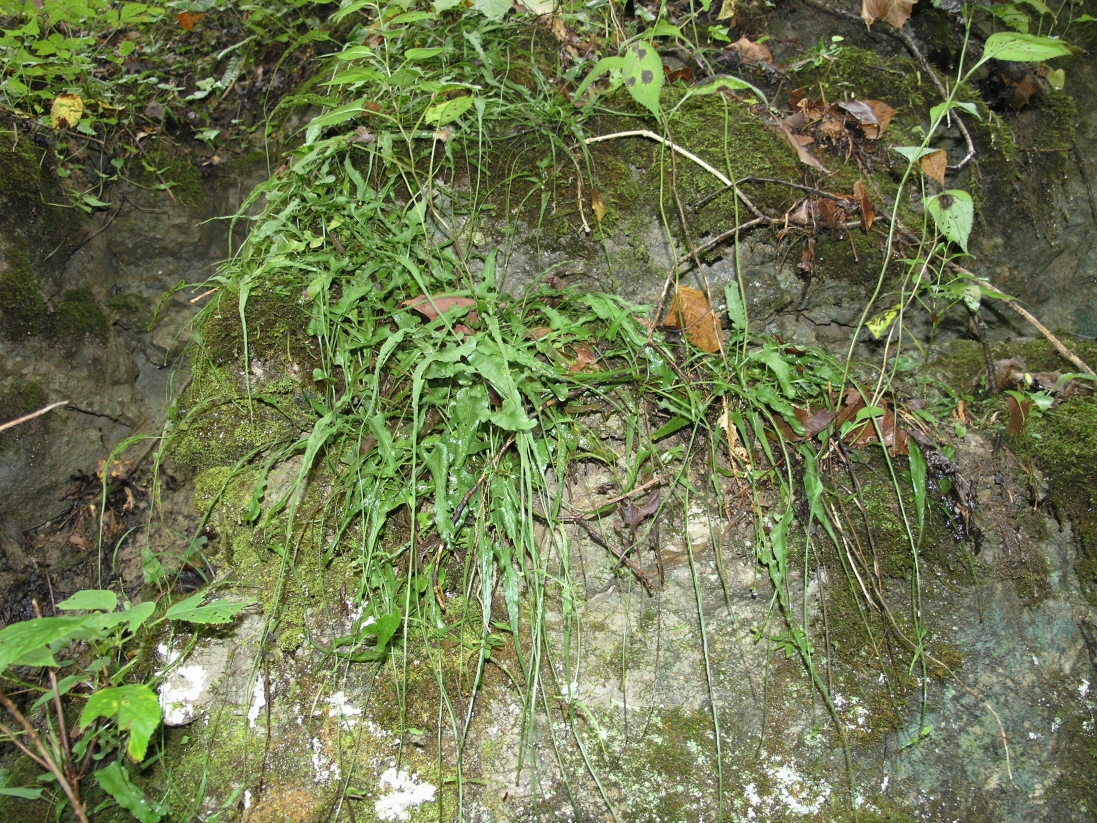|
Walking Fern
Walking fern may refer to two species of fern in the genus ''Asplenium'' which are occasionally placed in a separate genus ''Camptosorus''. The name "walking fern" derives from the fact that new plantlets grow wherever the arching leaves of the parent touch the ground, creating a walking effect. Both have evergreen, undivided, slightly leathery leaves which are triangular and taper to a thin point. On the bottom of the leaves, sori, or spore-bearing structures, cluster along the veins. These hardy plants can be found in shady spots of limestone ledges and limy forest places. *''Asplenium rhizophyllum'' (syn: ''Camptosorus rhizophyllum''), native to North America *'' Asplenium ruprechtii'' (syn: ''Camptosorus sibiricus''), native to East Asia It may also refer to: *'' Adiantum caudatum'', a species of maidenhair fern ''Adiantum'' (), the maidenhair fern, is a genus of about 250 species of ferns in the subfamily Vittarioideae of the family Pteridaceae, though some researcher ... [...More Info...] [...Related Items...] OR: [Wikipedia] [Google] [Baidu] |
Asplenium Rhizophyllum
''Asplenium rhizophyllum'', the (American) walking fern, is a frequently-occurring fern native to North America. It is a close relative of '' Asplenium ruprechtii'' (syn: ''Camptosorus sibiricus'') which is found in East Asia and also goes by the common name of "walking fern". Description ''Asplenium rhizophyllum'' is a small fern whose undivided, evergreen leaves and long, narrow leaf tips, sometimes curving back and rooting, give it a highly distinctive appearance. It grows in tufts, often surrounded by child plants formed from the leaf tips. The leaves of younger plants tend to lie flat to the ground, while older plants have leaves more erect or arching. Roots and rhizomes It does not spread and form new plants via the roots. Its rhizomes (underground stems) are upright or nearly so, short, about in diameter, and generally unbranched. They bear dark brown or blackish, narrowly triangular or lance-shaped scales which are strongly clathrate (bearing a lattice-like pattern). The ... [...More Info...] [...Related Items...] OR: [Wikipedia] [Google] [Baidu] |
Asplenium
''Asplenium'' is a genus of about 700 species of ferns, often treated as the only genus in the family Aspleniaceae, though other authors consider ''Hymenasplenium'' separate, based on molecular phylogenetic analysis of DNA sequences, a different chromosome count, and structural differences in the rhizomes. The type species for the genus is ''Asplenium marinum''. The most common vernacular name is spleenworts, applied to the more "typical" species. '' A. nidus'' and several similar species are called bird's-nest ferns, the ''Camptosorus'' group is known as walking ferns, and distinct names are applied to some other particularly well-known species. Taxonomy and genetics Many groups of species have been separated from ''Asplenium'' as segregate genera. These include ''Camptosorus'', ''Ceterach'', ''Phyllitis'', and ''Tarachia'', but these species can form hybrids with other ''Asplenium'' species and because of this are usually included in a more broadly defined ''Asplenium''. So ... [...More Info...] [...Related Items...] OR: [Wikipedia] [Google] [Baidu] |
Asplenium Ruprechtii
''Asplenium ruprechtii'', which goes by the common name Asian Walking Fern, is a rare, hardy, low-lying fern native to East Asia. It is a close relative of ''Asplenium rhizophyllum'' (syn: ''Camptosorus rhizophyllus'') which is found in North America and also goes by the common name of walking fern. The species should not be confused with ''Asplenium sibiricum'' which is a synonym of ''Diplazium sibiricum''. Description The name ''walking fern'' was derived from the way the fern spreads. The underside of each leaf contain sori, and when the tip of the leaf touches the ground, new planlets sprout, creating a "walking" effect. The evergreen In botany, an evergreen is a plant which has foliage that remains green and functional through more than one growing season. This also pertains to plants that retain their foliage only in warm climates, and contrasts with deciduous plants, which ..., undivided, slightly leathery leaves are triangular and taper to a thin point. Sori, the ... [...More Info...] [...Related Items...] OR: [Wikipedia] [Google] [Baidu] |
Adiantum Caudatum
''Adiantum caudatum'', commonly walking maidenhair, tailed maidenhair, trailing maidenhair is a fern in the genus ''Adiantum'' and the family Pteridaceae Pteridaceae is a family of ferns in the order Polypodiales, including some 1150 known species in ca 45 genera (depending on taxonomic opinions), divided over five subfamilies. The family includes four groups of genera that are sometimes recogni .... Distribution ''Adiantum caudatum'' can be found in shaded areas in south-east countries Bangladesh, Burma, India, Nepal, Philippines, Thailand, China, Vietnam. References External links Adiantum, caudatum {{Pteridaceae-stub ... [...More Info...] [...Related Items...] OR: [Wikipedia] [Google] [Baidu] |
Adiantum
''Adiantum'' (), the maidenhair fern, is a genus of about 250 species of ferns in the subfamily Vittarioideae of the family Pteridaceae, though some researchers place it in its own family, Adiantaceae. The genus name comes from Greek, meaning "unwetted", referring to the fronds' ability to shed water without becoming wet. Description They are distinctive in appearance, with dark, often black stipes and rachises, and bright green, often delicately cut leaf tissue. The sori are borne submarginally, and are covered by reflexed flaps of leaf tissue which resemble indusia. Dimorphism between sterile and fertile fronds is generally subtle. They generally prefer humus-rich, moist, well-drained sites, ranging from bottomland soils to vertical rock walls. Many species are especially known for growing on rock walls around waterfalls and water seepage areas. The highest species diversity is in the Andes. Fairly high diversity also occurs in eastern Asia, with nearly 40 species in China. ... [...More Info...] [...Related Items...] OR: [Wikipedia] [Google] [Baidu] |

